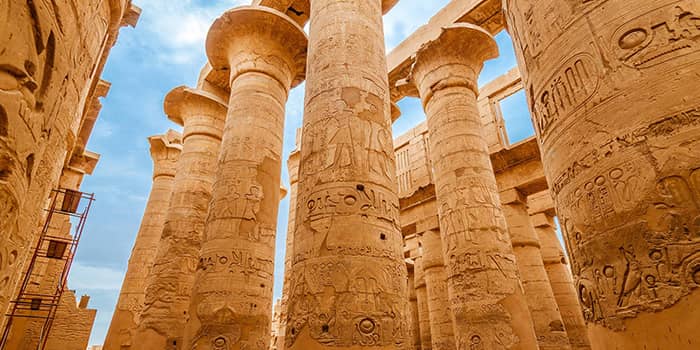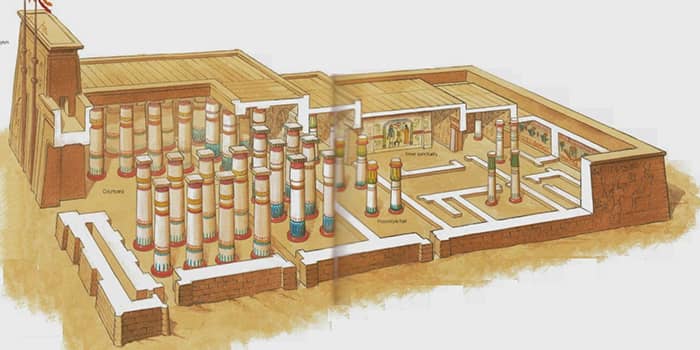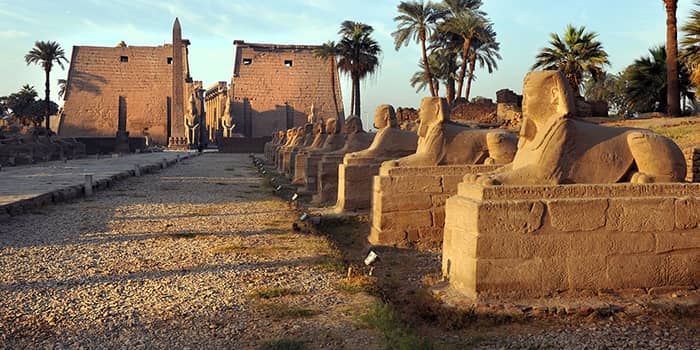
While in Luxor, you should not be missing such a particular spot, 2.5 km north to the city, you'll be in the presence of greatness, The Temple of Karnak, one of the most famous Egyptian monuments.
A proof of life and development, 30 kings were adding to it, not getting enough expansion, building more and more, it took almost 2000 years of Construction to show up as we see it now, maybe the longest in history.
Every king wanted to leave his print and to be remembered; they had nothing to do except coming here and building something new.

Karnak temple was constructed gradually over 2000 years.
Karnak Temple's size is so huge. It's considered the largest religious building ever built, covering 60 feddans (144000 square meters).
Three main temples exist in this area; that's why it's called the complex of Karnak or the temples of Karnak, dedicated to Amun-Ra or Amun-Re, Mut, and Montu.
Temple's definition is where the gods were worshiped; in Karnak, there are several sanctuaries of different gods from Egyptian Mythology, and in Arabic, Karnak means the "fortified village."
The answer to that question would be a little broad since it was built over 2000 years by several kings. The Construction started by Senusret I, one of the Middle Kingdom kings, around 2000-1700 BC, continued into the Ptolemaic period 305-30 BC."
Karnak Egypt is a village located in Upper Egypt, north of Luxor, the city of history, as it's full of Egyptian monuments.
And that's obvious from its name, that Luxor means palaces in Arabic when the early Arabs came here, they saw these temples look like palaces for them, so they gave it this name.
Simple question, not like its answer, so many Kings participated over centuries, so many dynasties left their prints, different civilizations, and even the early Christians in Egypt used it and left their imprints.
Such a location was chosen by Amenophis I in the new kingdom, to be the temple of God Amun or Amun Ra, in the middle of the ancient temple built during the middle kingdom. However, he died before the beginning of Construction.
Thutmose I had started the building by the 4th and 5th pylons with a hypostyle hall between them, with two red granite obelisks, 19.2 m tall.
Queen Hatshepsut had made some modifications herself. She added two more obelisks between the 4th and 5th pylons, 29.25 m tall. Also, she built some chapels and the 8th pylon.
Thutmose III also built some chapels as his stepmother, Hatshepsut, and added the 6th and the 7th pylons.
Ramses I started the Construction of the hypostyle hall after him, came Seti I to proceed it, to be fully accomplished during King Ramses II's reign, who had also added a massive statue of himself.
A lot more successors, kings, and rulers from different periods were adding to this monument to be the biggest of all the Egyptian temples.

The Karnak Temple is not really considered a temple; it is called Karnak Complex since it consists of several temples, courts, and halls. Let me take you on a tour around the temples of Karnak, explaining what you'll find at Karnak Complex.
Once was connecting Luxor Temple to Karnak Temple, 2700 meters long, and 76 meters wide walkway with sphinxes on both sides with rams heads symbolizing Amun Ra.
It was considered one of the longest walkways in the old world; it was built during the new kingdom and was accomplished by King Nectanebo I, who ruled between 380 and 363 BC.

The Temple of Amun at Karnak is the largest and most important. Amun was the sun god, which means in the old Egyptian language Ra or Re, that's why it was called Amun Ra or Amun Re.
The Temple of Karnak is famous for having the main Temple of Amun Re as one of the most important gods in Egyptian Mythology.
The Temple of Mut, the mother goddess who was also identified as Amun Ra's wife in the Eighteenth Dynasty.
The Temple of Montu, son of Amen-Re and Mut, the god of war, this temple is much smaller in size than the other ones.
Karnak temple inside is such a vast maze, with 134 columns lined up in 16 rows. It's the largest hall of hypostyle in Egyptian Architecture.
Amenophis III built the middle two rows. These columns are the tallest in this maze, 22.4 m in height considering the base, 19.25 m without the base, and 3.5 m in diameter.
The rest of the columns were built by Seti I, and Ramses II had decorated them with writings and drawings.
You can also find a Ramses statue in Karnak Temple, located in the open-air court, with a smaller figure of his wife between his legs.
The Karnak complex consists mainly of three areas, every area is surrounded by a wall made from raw earth bricks, and these walls were built during the reign of King Nectanebo I of the 30th dynasty.
The largest precinct, the Amun Ra area, has a large lake in its middle, the sacred lake, which the priests used for ritual washing and ritual navigation.
By this lake, there were storerooms and living quarters for the priests who lived in Karnak Temple.
The great Karnak Temple is such an inspiring location. It's where you can feel the greatness of Egyptian history. Every stone, column, pylon, and obelisk is a fingerprint of a king from a different era.
And that's a fun fact, as we cannot be accurate about Karnak Temple's age. No wonder it's the second most visited monument in Egypt after the Great Pyramids of Giza.
A Nile River cruise in Egypt is a journey through time, allowing you to explore this historic
The History of Ancient Egyptian Mummies is a captivating tale that weaves together the mysteries
Egypt is known for its rich history & amazing ancient wonders, but it also brags an incredible
Egypt, with its rich history, ancient wonders, and breathtaking landscapes, offers an unparalleled
Egypt, a land shrouded in mystique and grandeur, has a rich and captivating history spanning